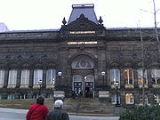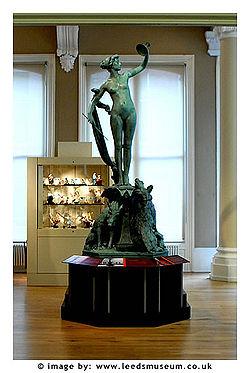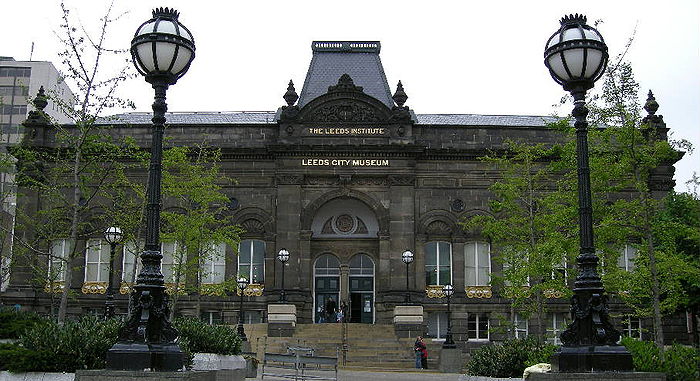
Leeds City Museum
Encyclopedia
Leeds City Museum, originally established in 1819, re-opened on 13 September 2008 in Leeds
, West Yorkshire
, England
. It is housed in the former Mechanics' Institute
built by Cuthbert Brodrick
, in Millennium Square, which has been redeveloped to a design by Austin-Smith:Lord
architects and Buro Happold
engineers. Gallery and exhibit design is provided by Redman Design.
Admission to the museum is free of charge. Special exhibitions are hosted alongside a collection of displays from the Leeds Archive.
, and in 1821 it opened to the public. In 1921, control of the museum was handed to the Corporation of Leeds which later became Leeds City Council
. In 1941 the museum building and artifacts were badly damaged by bombing. In 1965 the museum was closed, and a few exhibits removed to a couple of rooms in the city library in 1966. The oversized Leeds Tiger, the giant moose skeleton and the carved wooden cart took up much of the space. In 1999 the museum went into storage, though researchers and the public could view items by appointment. In 2000 the resource centre at Yeadon
opened, under the same appointment-to-view arrangement. In 2001 Leeds City Council bid for National Lottery
cash, and in 2004 it was awarded £19.5 million,
so in 2005 the Leeds Mechanics' Institute
building began to be re-designed as Leeds City Museum, finally to re-open in 2008.
. The exhibits are organised among several galleries. See a slideshow
here.

populace that when the curators wanted to throw it away, the Yorkshire Post
newspaper held a campaign to retain it - has a strange history. It was a tigerskin rug when presented to the Museum in the 19th century. Museum records give the impression that the tiger had been shot for spending too much time near a village in India
. The pelt was then combined with one or more other tigerskins, and instead of being mounted
properly it was stuffed with straw. For over a century it has sagged somewhat, as can be seen in the photograph. Meanwhile, the story of a tiger shot for its mere presence at the edge of a village became a legend of the killer of one man, then of two people, then the serial killer of forty. However the pelt may now be dangerous after all, in a sense, as the Victorians
may have preserved it with arsenic
al soap.
Museum staff have considered re-mounting it properly to improve its appearance, but it was felt that that would destroy its character and historical identity as a Victorian
artefact and as the centrepiece of the museum in the eyes of the citizens.

items from home and abroad.

Leeds
Leeds is a city and metropolitan borough in West Yorkshire, England. In 2001 Leeds' main urban subdivision had a population of 443,247, while the entire city has a population of 798,800 , making it the 30th-most populous city in the European Union.Leeds is the cultural, financial and commercial...
, West Yorkshire
West Yorkshire
West Yorkshire is a metropolitan county within the Yorkshire and the Humber region of England with a population of 2.2 million. West Yorkshire came into existence as a metropolitan county in 1974 after the passage of the Local Government Act 1972....
, England
England
England is a country that is part of the United Kingdom. It shares land borders with Scotland to the north and Wales to the west; the Irish Sea is to the north west, the Celtic Sea to the south west, with the North Sea to the east and the English Channel to the south separating it from continental...
. It is housed in the former Mechanics' Institute
Mechanics' Institutes
Historically, Mechanics' Institutes were educational establishments formed to provide adult education, particularly in technical subjects, to working men...
built by Cuthbert Brodrick
Cuthbert Brodrick
Cuthbert Brodrick FRIBA was a British architect, whose most famous building is Leeds Town Hall.- Early life :...
, in Millennium Square, which has been redeveloped to a design by Austin-Smith:Lord
Austin-Smith:Lord
Austin-Smith:Lord is a British architectural firm, established in 1949.Currently in voluntary administration following staff redundancies in November 2011.-Selected designs:*Riverfront Arts Centre*Avril Robarts LRC*Catalyst...
architects and Buro Happold
Buro Happold
Buro Happold is a professional services firm providing engineering consultancy, design, planning, project management and consulting services for all aspects of buildings, infrastructure and the environment, with its head office in Bath, Somerset...
engineers. Gallery and exhibit design is provided by Redman Design.
Admission to the museum is free of charge. Special exhibitions are hosted alongside a collection of displays from the Leeds Archive.
History
In 1819 a museum was established on Park Row by the Leeds Philosophical and Literary SocietyLeeds Philosophical and Literary Society
thumb|rightLeeds Philosophical and Literary Society is a Learned society in Leeds, West Yorkshire, England. It was founded in 1819, and its museum collection forms the basis of Leeds City Museum, which reopened in September 2008...
, and in 1821 it opened to the public. In 1921, control of the museum was handed to the Corporation of Leeds which later became Leeds City Council
Leeds City Council
Leeds City Council is the local authority for the City of Leeds metropolitan district of West Yorkshire, England.-History:The city council was established in 1974, with the first elections being held in advance in 1973...
. In 1941 the museum building and artifacts were badly damaged by bombing. In 1965 the museum was closed, and a few exhibits removed to a couple of rooms in the city library in 1966. The oversized Leeds Tiger, the giant moose skeleton and the carved wooden cart took up much of the space. In 1999 the museum went into storage, though researchers and the public could view items by appointment. In 2000 the resource centre at Yeadon
Yeadon, West Yorkshire
Yeadon is a town within the City of Leeds metropolitan borough, in West Yorkshire, England. It is home to Leeds Bradford International Airport.-History:...
opened, under the same appointment-to-view arrangement. In 2001 Leeds City Council bid for National Lottery
National Lottery (United Kingdom)
The National Lottery is the state-franchised national lottery in the United Kingdom and the Isle of Man.It is operated by Camelot Group, to whom the licence was granted in 1994, 2001 and again in 2007. The lottery is regulated by the National Lottery Commission, and was established by the then...
cash, and in 2004 it was awarded £19.5 million,
so in 2005 the Leeds Mechanics' Institute
Mechanics' Institutes
Historically, Mechanics' Institutes were educational establishments formed to provide adult education, particularly in technical subjects, to working men...
building began to be re-designed as Leeds City Museum, finally to re-open in 2008.
The exhibits
While exhibits vary, they are mainly made up of exhibits from Leeds' history. The central hall has a large map of Leeds printed on the floor. There is also a scale model of the Quarry Hill flatsQuarry Hill, Leeds
Quarry Hill is an area of central Leeds, West Yorkshire, England. It is surrounded by the Leeds Inner Ring Road to the east and north. The Leeds - York / Hull railway runs just south of the district into the city centre...
. The exhibits are organised among several galleries. See a slideshow
here.

The Leeds Tiger
This exhibit - so beloved of the LeedsLeeds
Leeds is a city and metropolitan borough in West Yorkshire, England. In 2001 Leeds' main urban subdivision had a population of 443,247, while the entire city has a population of 798,800 , making it the 30th-most populous city in the European Union.Leeds is the cultural, financial and commercial...
populace that when the curators wanted to throw it away, the Yorkshire Post
Yorkshire Post
The Yorkshire Post is a daily broadsheet newspaper, published in Leeds, West Yorkshire, England by Yorkshire Post Newspapers, a company owned by Johnston Press...
newspaper held a campaign to retain it - has a strange history. It was a tigerskin rug when presented to the Museum in the 19th century. Museum records give the impression that the tiger had been shot for spending too much time near a village in India
India
India , officially the Republic of India , is a country in South Asia. It is the seventh-largest country by geographical area, the second-most populous country with over 1.2 billion people, and the most populous democracy in the world...
. The pelt was then combined with one or more other tigerskins, and instead of being mounted
Taxidermy
Taxidermy is the act of mounting or reproducing dead animals for display or for other sources of study. Taxidermy can be done on all vertebrate species of animals, including mammals, birds, fish, reptiles, and amphibians...
properly it was stuffed with straw. For over a century it has sagged somewhat, as can be seen in the photograph. Meanwhile, the story of a tiger shot for its mere presence at the edge of a village became a legend of the killer of one man, then of two people, then the serial killer of forty. However the pelt may now be dangerous after all, in a sense, as the Victorians
Victorian era
The Victorian era of British history was the period of Queen Victoria's reign from 20 June 1837 until her death on 22 January 1901. It was a long period of peace, prosperity, refined sensibilities and national self-confidence...
may have preserved it with arsenic
Arsenic
Arsenic is a chemical element with the symbol As, atomic number 33 and relative atomic mass 74.92. Arsenic occurs in many minerals, usually in conjunction with sulfur and metals, and also as a pure elemental crystal. It was first documented by Albertus Magnus in 1250.Arsenic is a metalloid...
al soap.
Museum staff have considered re-mounting it properly to improve its appearance, but it was felt that that would destroy its character and historical identity as a Victorian
Victorian era
The Victorian era of British history was the period of Queen Victoria's reign from 20 June 1837 until her death on 22 January 1901. It was a long period of peace, prosperity, refined sensibilities and national self-confidence...
artefact and as the centrepiece of the museum in the eyes of the citizens.

Ancient Worlds gallery
Here are archaeologicalArchaeology
Archaeology, or archeology , is the study of human society, primarily through the recovery and analysis of the material culture and environmental data that they have left behind, which includes artifacts, architecture, biofacts and cultural landscapes...
items from home and abroad.
- RomanRoman EmpireThe Roman Empire was the post-Republican period of the ancient Roman civilization, characterised by an autocratic form of government and large territorial holdings in Europe and around the Mediterranean....
floor mosaicMosaicMosaic is the art of creating images with an assemblage of small pieces of colored glass, stone, or other materials. It may be a technique of decorative art, an aspect of interior decoration, or of cultural and spiritual significance as in a cathedral...
ca 250 CE. This was discovered at Aldborough (Yorkshire), known to the Romans as Isurium BrigantumIsurium BrigantumIsurium Brigantum was a town in the Roman province of Britannia. Today it is known as Aldborough, in North Yorkshire, England.-Possible Roman fort:...
. - Hellenistic GreekHellenistic GreeceIn the context of Ancient Greek art, architecture, and culture, Hellenistic Greece corresponds to the period between the death of Alexander the Great in 323 BC and the annexation of the classical Greek heartlands by Rome in 146 BC...
tomb doors ca 250 BCE. These are carved in marble, in bas reliefReliefRelief is a sculptural technique. The term relief is from the Latin verb levo, to raise. To create a sculpture in relief is thus to give the impression that the sculpted material has been raised above the background plane...
. - The Leeds MummyNesyamunNesyamun otherwise known as The Leeds Mummy, and his coffins are amongst the best researched of their kind. Nesyamun was a priest, incense-bearer and scribe at the ancient Egyptian temple complex at Karnak and died over 3,000 years ago, around 1100 BC. His body was then preserved and entombed ready...
. In the 1941 bombing raids, two other mummiesMummyA mummy is a body, human or animal, whose skin and organs have been preserved by either intentional or incidental exposure to chemicals, extreme coldness , very low humidity, or lack of air when bodies are submerged in bogs, so that the recovered body will not decay further if kept in cool and dry...
were destroyed, but NesyamunNesyamunNesyamun otherwise known as The Leeds Mummy, and his coffins are amongst the best researched of their kind. Nesyamun was a priest, incense-bearer and scribe at the ancient Egyptian temple complex at Karnak and died over 3,000 years ago, around 1100 BC. His body was then preserved and entombed ready...
's 3000-year-old mummyMummyA mummy is a body, human or animal, whose skin and organs have been preserved by either intentional or incidental exposure to chemicals, extreme coldness , very low humidity, or lack of air when bodies are submerged in bogs, so that the recovered body will not decay further if kept in cool and dry...
survived. It is displayed in the current museum building, alongside a rather striking reconstruction of his face. - Iron replica of Hellenistic GreekHellenistic GreeceIn the context of Ancient Greek art, architecture, and culture, Hellenistic Greece corresponds to the period between the death of Alexander the Great in 323 BC and the annexation of the classical Greek heartlands by Rome in 146 BC...
head of AphroditeAphroditeAphrodite is the Greek goddess of love, beauty, pleasure, and procreation.Her Roman equivalent is the goddess .Historically, her cult in Greece was imported from, or influenced by, the cult of Astarte in Phoenicia....
. This is a cast replica of the original 1st century BCE head in the British MuseumBritish MuseumThe British Museum is a museum of human history and culture in London. Its collections, which number more than seven million objects, are amongst the largest and most comprehensive in the world and originate from all continents, illustrating and documenting the story of human culture from its...
. The original was discovered in 1872 at SatalaSatalaLocated in Turkey, the city of Satala , according to the ancient geographers, was situated in a valley surrounded by mountains, a little north of the Euphrates, where the road from Trapezus to Samosata crossed the boundary of the Roman Empire...
(now Sadak) in north-eastern TurkeyTurkeyTurkey , known officially as the Republic of Turkey , is a Eurasian country located in Western Asia and in East Thrace in Southeastern Europe...
. The eyes were once inlaid with precious stones or paste. Apparently the top of the head was not designed to be empty, like a piece of modern art. It seems that the farmer found it when he hit the top of the head with his axe and damaged it.
Collectors Corner and shop
Various collections appear here in rotation.- The CirceCirceIn Greek mythology, Circe is a minor goddess of magic , described in Homer's Odyssey as "The loveliest of all immortals", living on the island of Aeaea, famous for her part in the adventures of Odysseus.By most accounts, Circe was the daughter of Helios, the god of the sun, and Perse, an Oceanid...
bronze by Alfred DruryAlfred DruryAlfred Briscoe Drury, was an English architectural sculptor and figure in the New Sculpture movement.Born in London, Drury studied under Edouard Lanteri and Jules Dalou, with whom he worked between 1881 and 1885, and then became assistant to Joseph Boehm.Drury is best represented at the Victoria...
. This was commissioned from Drury in 1894 by Leeds Art GalleryLeeds Art GalleryLeeds Art Gallery in Leeds, West Yorkshire, England is a museum whose collection of 20th century British Art is recognised by the British government as a collection "of national importance". Its collection also includes 19th century and earlier art works. The gallery opened on 3 October 1888 as...
. It was displaced to Park Square in the 1950s when VictorianVictorian eraThe Victorian era of British history was the period of Queen Victoria's reign from 20 June 1837 until her death on 22 January 1901. It was a long period of peace, prosperity, refined sensibilities and national self-confidence...
art went out of fashion. It was weathered and damaged, but has been restored recently. It was Drury who made the eight beautiful bronze lampholder girls in Leeds City SquareLeeds City SquareCity Square is a paved open area in Leeds city centre in West Yorkshire, England.In 1897, the Leeds city council of the time wanted to improve the open space near to the Post Office and in 1899 work was completed. The city square was enhanced with the erection of statues, the grandest being the...
, plus the bronze of Joseph PriestleyJoseph PriestleyJoseph Priestley, FRS was an 18th-century English theologian, Dissenting clergyman, natural philosopher, chemist, educator, and political theorist who published over 150 works...
nearby.
Photographs of some of the exhibits


